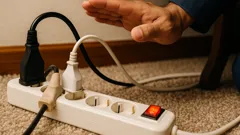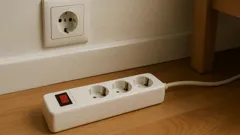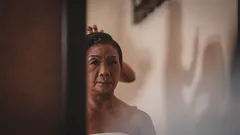
Have you ever wondered if your power strip might be making your home less safe? In many Filipino homes, power strips are used daily for charging gadgets or plugging in kitchen appliances. But did you know that placing a power strip in the wrong area can put your home at risk? Let’s discuss the spots in your house where electricians recommend you don’t install a power strip, and learn how to keep your family safe from possible electrical emergencies.
Why Power Strip Placement Matters in Filipino Homes
In the Philippines, it’s a common sight to use a power extension or what’s locally called Octopus wiring for plugging in many appliances at once. In fact, 8 out of 10 households have at least one. But if these are used incorrectly, it may lead to overloading—the leading cause of house fires, according to the Bureau of Fire Protection. So, it’s not just about convenience—it’s about your safety!

Common Mistake #1: Wet Areas Like Kitchens and Bathrooms
One of the riskiest mistakes you can make is to put a power strip near water, like in the kitchen or beside the toilet. Moisture mixed with electricity is a dangerous combination and can cause short circuits or even electrocution. Make sure your power strips are kept away from water sources. It’s better to use wall outlets for heavy-duty appliances and always dry your hands before plugging or unplugging anything.
Common Mistake #2: Under Carpets and Mats
Many Filipino homes use carpets or floor mats to protect the floors, but placing a power strip under these can trap heat, leading to overheating and worse, a fire. Last year alone, more than 2,000 house fires in the Philippines were reported, many due to overheated electrical equipment. Give your power strip space to breathe to keep your home safer!
"Give your power strip room to breathe. Overheating is the silent cause for numerous household incidents across the Philippines."
Common Mistake #3: Behind Furniture or Inside Cabinets
It might look tidy to hide cables behind a sofa or inside a cabinet, but experts say blocking airflow can make your power strip get very hot. Hiding it behind bulky furniture may even cause you to miss early warning signs—like a warm casing or a faint burning smell. Always check your power strips and keep them out in the open!
Checklist: Where to Avoid Installing Your Power Strip
- Near water: utensil racks, kitchen sinks, and bathroom floors
- Carpets or under mats: sala or bedroom rugs
- Behind cabinets or appliances: TV cabinets, bedside tables
- Outdoor spaces: balconies or open areas that might get wet from rain
Better Practices for Everyday Safety
To avoid accidents, use power strips only for low-wattage devices like chargers or computers—never for high-wattage appliances like irons or rice cookers. If you notice warning signs (such as warm outlets or a burning smell), unplug the device right away and call a certified electrician.
Safety at home starts with simple habits: check your extension cords frequently and only use each outlet for devices that fit its wattage limits. As Filipino electricians say, a little extra attention goes a long way!
The next time you re-arrange your sala or do a deep clean in your kitchen, check where you’ve placed your extension cords. Small choices can make a massive impact on home safety. For more tips on how to use your power extension safely in the Philippines, review the expert advice above. Stay safe and enjoy peace of mind in your wonderful home!
 Meg Magazine
Meg Magazine



Comments